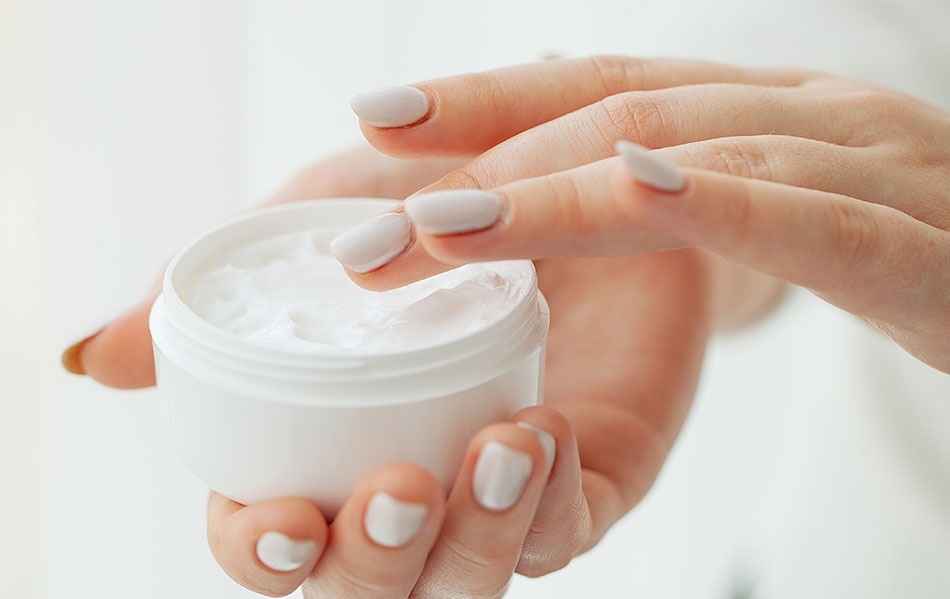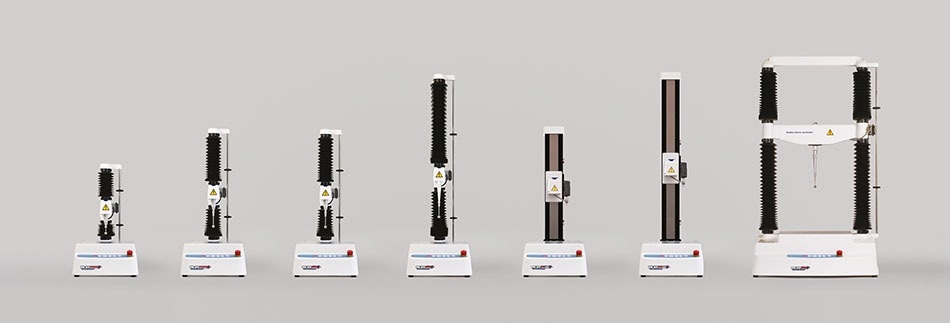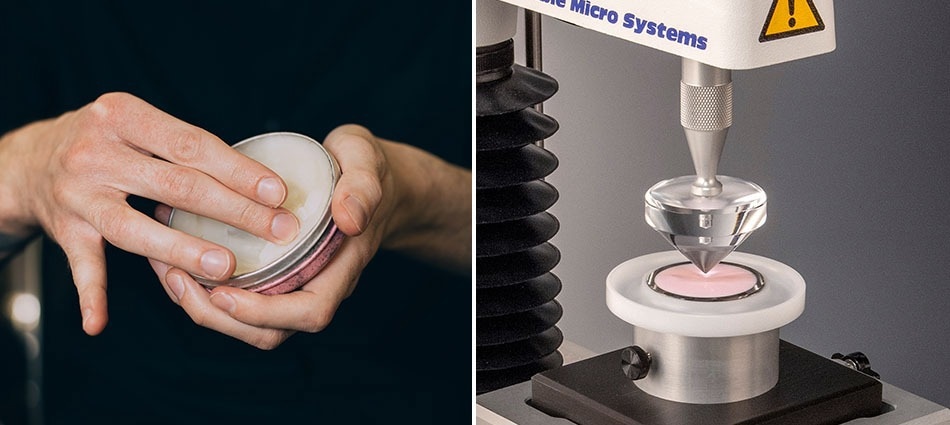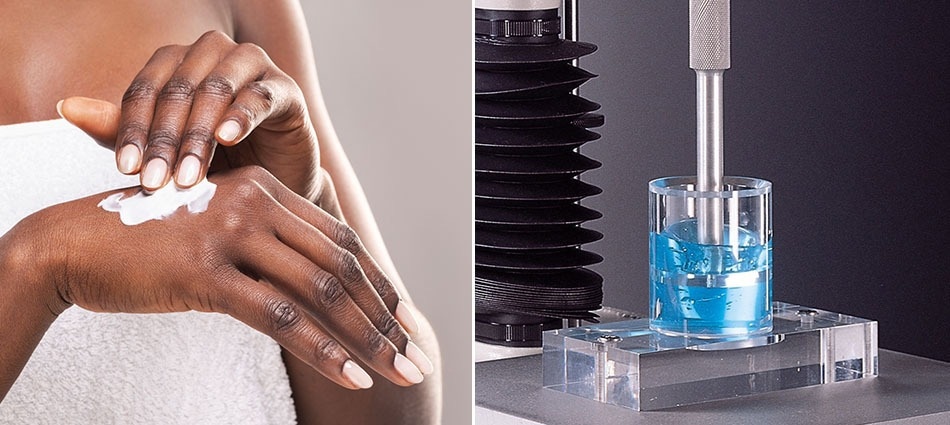Increased attention has been focused on the objective evaluation of personal care products to improve their performance and to fulfill the requirements in legislation demanding proof of certain product claims. Advances in personal care products consist of a succession of small improvements.

Image Credit: Stable Micro Systems Ltd
Companies often need to start at an early stage of product development to evaluate products for verifiable changes. Minor improvements in product performance require carefully conducted experiments in order to provide definite information. Likewise, it is important to obtain knowledge about competitors’ products and to reach competitive advantages; this comparison with competitors is useful for product positioning. Information about the product’s performance can be obtained by texture analysis testing using a TA.XTplusC/TA.HDplusC Texture Analyser. Texture Analysis can play a pivotal role in measuring product conformity and compliance with standards, as well as analysing and controlling the desired textural features/properties of any new or existing product for the market. Analysis of the way in which different types of personal care products respond to the tests provide the manufacturer with vital information: which combination of ingredients is the ideal for a particular product; which processing methods/times produce the best results; whether the quality is consistent.

A range of Texture Analysers varying in maximum force capacity. Image Credit: Stable Micro Systems Ltd
How to Measure Stickiness

Wax adhesive test using a 0.5” hemispherical probe. Image Credit: Stable Micro Systems Ltd
Hair waxes and pomades are the most versatile styling products available, but they may be heavy and greasy if not applied properly and can come in a wide range of hardness and stickiness. The interior stickiness or cohesiveness of the waxy substance contributes to its gripping capacity. Since the waxy ingredients are not soluble in water, they do not "dry." The bonds can be readily remoulded by running your hands through your hair, which is a positive consequence of not drying; the disadvantage is that formulations may become sticky.
If the product surface is not flat, a straightforward penetration test utilising a hemispherical probe or spherical probe can measure the firmness of the product. Depending on the desired final product consistency, such measurements are useful for choosing or specifying, or both, a wax of a specific consistency or firmness. The TA.XTPlus Texture Analyzer can be controlled by Exponent software in a unique adhesion test. The force required to separate the two surfaces is measured and used as a gauge of the product's stickiness, adhesiveness, or tackiness after the probe applies a specified force to the sample's surface for a specified amount of time (to ensure good contact between the two surfaces). Stickiness is correlated with the magnitude of the absolute positive value on the graphic that is produced. The energy needed to separate the wax from the probe's "Work of Adhesion" is depicted by the region beneath the curve profile. The stickier the sample, the higher the peak force.
How to Measure Spreadability
Penetration and compression style tests are simple methods that give results of sample hardness. However, hardness measurements, even with cone probes, are not always good discriminators of spreadability. Spreadability, in pragmatic terms, is the ease with which a product can be applied in a thin, even layer. Firmness or hardness may be measured by the force required to obtain a given deformation or by the amount of deformation under a given force. Although spreadability is also a deformation under an external load, it is a more dynamic property.

Spreadability measurement of a wax sample using the Spreadability Rig with catchment collar fitted. Image Credit: Stable Micro Systems Ltd
Measurements of firmness and spreadability are usually highly correlated; however the relationship is rarely perfect, and this is partly a function of work softening. Some waxes work-soften more easily than others, which allows them to be more spreadable even when hardness values are initially equal. The Spreadability Rig is a set of precisely matched male and female perspex 45° cones. The material is allowed to set up in the lower cone or is filled into the lower cone with a spatula. The material is pressed down only so much as is needed to eliminate air pockets which are visible through the perspex cones, and then the surface is levelled with a flat knife.
The important action that the test is designed to measure, spreadability, occurs only in the later stages of the test. During these stages the product is squeezed out from between the male and female cones. The cone-shaped holder offers no locations into which the product can be packed or compressed, so the product flows outward between the male and female cone surfaces. The probe withdrawal, i.e. looking at the negative forces, may also offer some insights into adhesive behaviours. The peak force (maximum force to shear) and ‘work of shear’ (area under the curve = total amount of energy required to perform the procedure) are recorded. Both of these values have been shown to rank samples in the same order of spreadability (and firmness), but for other samples one may prove to be more suitable than the other.
Measuring Consistency
When formulating products such as moisturising creams, lotions, shampoos and conditioners, the materials to be used will depend largely upon the required end product consistency. A thin lotion or shampoo for easy pouring will require the addition of different ingredients or quantities than that required for a thick cream or conditioner. A product developer may wish to create a product that squeezes out of a tube and breaks sharply after squeezing. These consistencies can be assessed by either a Forward Extrusion test (simulating the force required to extrude the sample by the consumer) or a Backward Extrusion test, which will give an indication of product physical failure and consistency/cohesiveness.
Backward extrusion tests are often preferred, as the product may be tested directly from the container in which it was originally dispensed, thereby avoiding disruption of the sample and potential changes of properties prior to testing. When the back extrusion disc’s lower surface is in full contact with the product, the disc proceeds to penetrate to a user-defined depth into the container. At this point (most likely to be the maximum force), the probe returns to its original position. The maximum force is taken as a measurement of firmness - the higher the value, the firmer the sample. The positive area of the curve is taken as a measurement of consistency - the higher the value, the thicker the consistency of the sample. The negative region of the graph, produced on probe return, is as a result of the weight of sample that has lifted primarily on the upper surface of the disc on return – i.e. due to back extrusion – and hence gives an indication of consistency/resistance to flow off the disc. The maximum negative force is taken as an indication of the cohesiveness of the sample - the more negative the value, the more resistance to withdraw the probe, and hence the more cohesive the sample.


Consistency measurement of semi-solid or viscous liquid personal care samples using the Forward Extrusion Rig (top left) and Backward Extrusion Rig (bottom right). Image Credit: Stable Micro Systems Ltd
For a full summary of typical texture analysis tests that can be performed on personal care products:
Cosmetics & Skincare Product Texture Measurement & Analysis
Video Credit: Stable Micro Systems Ltd

This information has been sourced, reviewed and adapted from materials provided by Stable Micro Systems Ltd.
For more information on this source, please visit Stable Micro Systems Ltd.